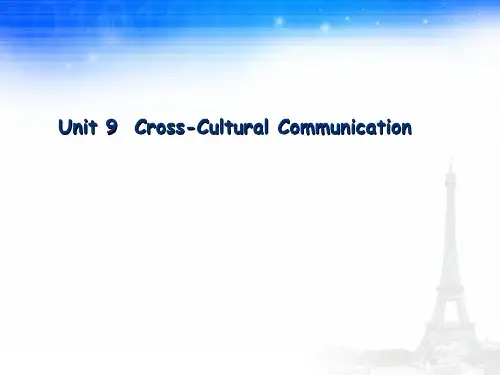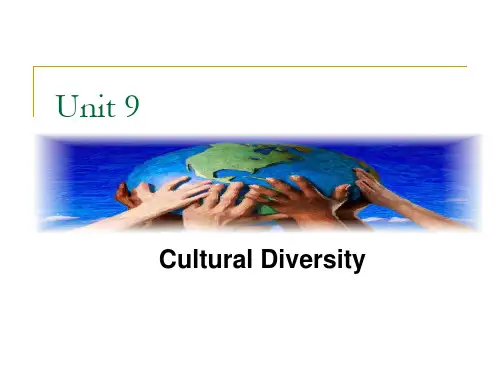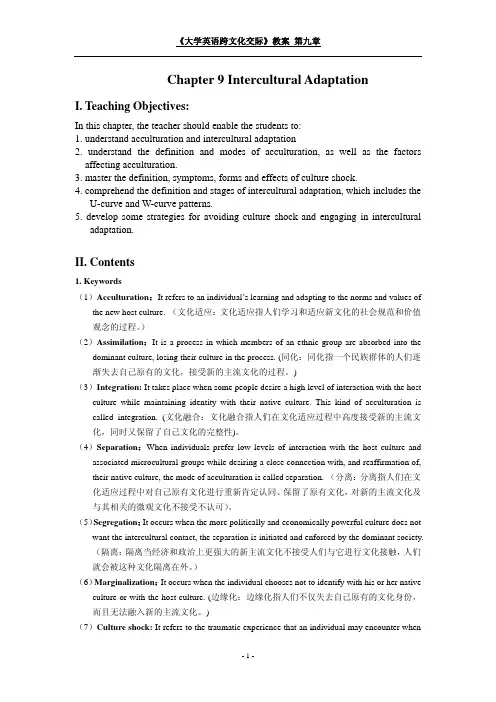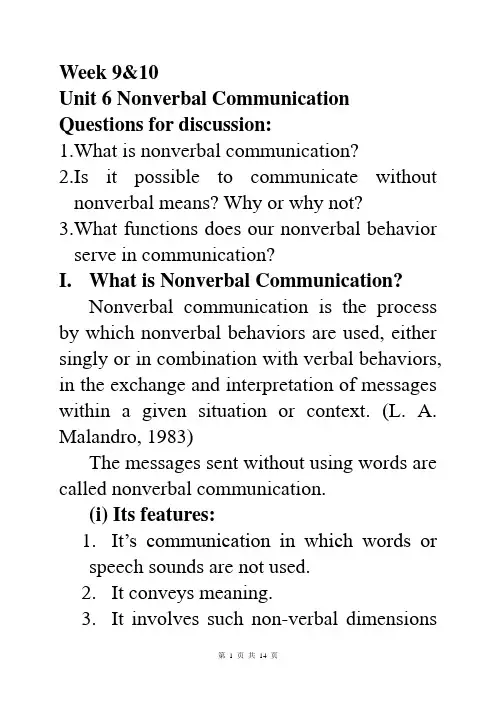跨文化交际课程unit9
- 格式:ppt
- 大小:933.00 KB
- 文档页数:35




Chapter 9 Intercultural AdaptationI. Teaching Objectives:In this chapter, the teacher should enable the students to:1. understand acculturation and intercultural adaptation2. understand the definition and modes of acculturation, as well as the factors affecting acculturation.3. master the definition, symptoms, forms and effects of culture shock.4. comprehend the definition and stages of intercultural adaptation, which includes theU-curve and W-curve patterns.5. develop some strategies for avoiding culture shock and engaging in interculturaladaptation.II. Contents1. Keywords(1)Acculturation:It refers to an individual’s learning and adapting to the norms and values of the new host culture. (文化适应:文化适应指人们学习和适应新文化的社会规范和价值观念的过程。
)(2)Assimilation:It is a process in which members of an ethnic group are absorbed into the dominant culture, losing their culture in the process. (同化:同化指一个民族群体的人们逐渐失去自己原有的文化,接受新的主流文化的过程。


Week 9&10Unit 6 Nonverbal Communication Questions for discussion:1.What is nonverbal communication?2.Is it possible to communicate without nonverbal means? Why or why not?3.What functions does our nonverbal behavior serve in communication?I.What is Nonverbal Communication?Nonverbal communication is the process by which nonverbal behaviors are used, either singly or in combination with verbal behaviors, in the exchange and interpretation of messages within a given situation or context. (L. A. Malandro, 1983)The messages sent without using words are called nonverbal communication.(i) Its features:1.It’s communication in which words orspeech sounds are not used.2.It conveys meaning.3.It involves such non-verbal dimensionsas facial expressions, touch, time, gestures, smile, eye behaviors, smell, intonation, etc.4.It’s a discipline studying non-verbalbehavior in communication.5.It’s first of all used to convey messagesto and receive messages from others.6.It’s a process of communication bymeans of non-verbal behaviors.7.It may convey messages alone or incombination with verbal behaviors.8.It occurs in a given context or situationand is interpreted in relation to that situation or context.(ii) Its significanceNonverbal behavior is a significant area of communication study for at least three reasons. ♦Nonverbal behavior accounts for much of the meaning we get from conversations.♦Nonverbal behavior spontaneously reflects the subconsciousness. They are relatively free of distortions and deception.♦We cannot avoid communicating throughnonverbal signals.Besides, nonverbal behavior is significant because nonverbal communication can be open to many interpretations.(iii) Its functions (p 227-231):1.Repeating: People use nonverbalcommunication to repeat, clarify, and emphasize their point of view.plementing: Nonverbalcommunication cues can add to or complement a verbal message.3.Substituting: Nonverbal messages maysubstitute verbal ones in certain settings.4.Regulating: Nonverbal behaviors canhelp control verbal interactions by regulating them, such as turn-taking signals (hand raised) in conversations.5.Contradicting: Certain nonverbalbehaviors can contradict spoken words.E.g. Saying you are relaxed and at easewith quavering voices or shaking hands.(iv)❊Non-verbal communicationincludes: (Knapp, 1972)kinesics or body language, eye movement, facial expressions, proxemics and paralanguage.II.KinesicsKinesics, that is commonly called as body language, is the term used for communicating through various types of body movements including gestures, posture, touching, and other mannerisms that may accompany or replace oral messages.(i) Gestures: (p203-205)Gestures are an important component of non-verbal communication. This is mainly a matter of how we use our hands to convey a message. The language of the hands differs from country to country and a gesture which means one thing in one country may well mean something quite different to those living in another.1.Similarities:①Rubbing one’s thumb against one’sforefinger and middle finger—money inChinese and English.②Shaking one’s head—disagreement or disappointment.③Shaking hands when introduced or meeting together after a long time.2.Differences:①It’s me or I’m the one—touch or point toone’s nose by raised thumb.②Come here—extending a closed hand,palm up, with only the forefinger movingback and forth.③Shame on you—extending both hands,palms down, with forefingers stretchingout and one forefinger makes severalbrushing movements over the back of theother forefinger.④Hitchhiking—moving several time aclosed hand with an outstretched thumbopinion to the intended direction.(American method)—walking on the same side of theroad and in the same direction as thecar traffic, and extend the thumb ofyour roadside arm toward the front.(European method)⑤Kill oneself—raising one’s closed handto one’s head with the forefinger and the thumb stretching out and the forefinger pointing to the temple.⑥I’m full—an open hand, palm down,raised to ones throat⑦Good luck—crossing one’s forefingerand middle finger.⑧Stamping one’s foot—impatience.⑨Thumbing one’s nose (one thumb on thetip of one’s own nose with other finger s curled and moving together)—defiance and contempt.⑩W agging one’s forefinger (the forefinger of one hand is raised and wagged from side to side while other fingers are lasped)—warning.※more materials will be shown on PPT“Gesture”.Exercise p214(ii) Posture身势语:Posture, the way someone stands, sits, or walks, can send positive or negative nonverbal messages. Posture can signal agreement or disagreement. Appropriate posture is related to a person’s status in society. For example, the manager may stand erect when talking to subordinates, but the subordinates may drop their shoulders when talking to the manager.English speakers’, especially Americans’ postures are more casual than Chinese speakers’: ①sitting on a desk with both feet on another desk. ②Putting one’s feet on the writing table in a crowded office while sitting in an armchair. ③Making big strides while walking. ④Sitting on the grass or on the carpet (but never squatting in public).※In western conversation, the speaker who is standing is superior to the other who is sitting in ranks or status or ages. It is the opposite inChinese conversation. The junior or inferior one should stand and show his/her respect and subordinate to the senior or superior.(iii) Touching behavior: (p 210-212) Differences in touching behavior are highly correlated with culture. People in high contact cultures evaluate “close ”as positive and good, and evaluate “far” as negative and bad. People in low contact cultures evaluate “close ”as negative and bad, and evaluate “far” as positive and good1. handshaking2. embrace3. kiss(iv) artifacts or attireIII.E ye movement (p205-208)Eye contact is an important aspect of body language. One could draw up quite rules about eye contact: to look or not to look, when to look and how long to look, and who not to look at, etc. And these rules vary from culture to culture.When conversing with English speakers, we had better prolong eye contact with them. Look at the speaker directly in the eye while listening, and look away intermittently while speaking.Staring or gaping shows one’s curiosity or surprise in Chinese but impoliteness or embarrassment in English. A prolonged gaze or stare in the United States is considered rude. In other cultures such as Japan, Korea, and Thailand, staring is also considered rude. Inmost cultures, men do not stare at women. In France and Italy, however, men can stare at women in public. In the United States, staring at a person is considered a sign of interest and may even be interpreted as sexually suggestive.IV.Facial expressions:1. Read over the article (p208-210) and explain the different understanding of smiles at a stranger in these countries.Japan: either a sexual maniac or an impolite person.Korea: never talk or smile at strangers. Arab: something wrong with the stranger’s clothes or others.Vietnam: Americans are superficial for they smile too much. Nonverbal language, like a silence, a smile, a glance, has its own meaning.※Laughing: A native English speaker walking along the street suddenly stumble and fell. The Chinese persons who saw this laughed.※Smiling: Both Chinese and English speakers would smile when they meet friends, colleagues, classmates or acquaintances. But Americans tend to smile even to strangers to show friendliness. Even a girl may smile to a male stranger for no reason other than showing friendliness.2. Read case 22 on p216-217. What does laughing serve in the mentioned situation?V.Paralanguage (p201-203)We communicate with more than the words we speak. Effective speakers use vocal qualities to suggest different meanings from exactly the same words, like the manner of speech, intonation.VI.Some Nonverbal Patterns in the Black Culture (p218-221)1.rolling the eyes2.the reluctance to look another persondirectly in the eye3.limp stance4.Black walkVII.Silence in Western Apache Culture1.meeting strangers:2.courting3.children, coming home VIII.Case Analysis Case 20 (p214-215) Case 21 (p215-216) Case 22 (p216-217)。




跨文化交际全部答案(总30页) -CAL-FENGHAI.-(YICAI)-Company One1-CAL-本页仅作为文档封面,使用请直接删除参考资料Unit 1 Communication Across CulturesReading IIntercultural Communication:An Introduction Comprehension questions1. Is it still often the case that “everyone‟s quick to blame the alien” in the contemporary worldThis is still powerful in today‘s social and political rhetoric. For instance, it is notuncommon intoday‘s society to hear people say that most, if not all, of the social and economic problems arecaused by minorities and immigrants.2. What‟s the difference between today‟s intercultural contact and that of any time in the pastToday‘s intercultural encounters are far more numerous and of greater importancethan in anytime in history.3. What have made intercultural contact a very common phenomenon in our life todayNew technology, in the form of transportation and communication systems, has accelerated intercultural contact; innovative communication systems have encouraged and facilitated cultural interaction; globalization of the economy has brought people together; changes in immigration patterns have also contributed to intercultural encounter.4. How do you understand the sentence “culture is everything and everywhere”Culture supplies us with the answers to questions about what the world looks like and how we live and communicate within that world. Culture teaches us how to behave in our life from the instant of birth. It is omnipresent.5. What are the major elements that directly influence our perception and communicationThe three major socio-cultural elements that directly influence perception and communication are cultural values, worldview (religion), and social organizations (family and state).6. What does one‟s family teach him or her while he or she grows up in itThe family teaches the child what the world looks like and his or her place in thatworld.7. Why is it impossible to separate our use of language from our cultureBecause language is not only a form of preserving culture but also a means of sharing culture. Language is an organized, generally agreed-upon, learned symbol system that is used to represent the experiences within a cultural community.8. What are the nonverbal behaviors that people can attach meaning toPeople can attach meaning to nonverbal behaviors such as gestures, postures, facial expressions, eye contact and gaze, touch, etc.9. How can a free, culturally diverse society existA free, culturally diverse society can exist only if diversity is permitted to flourish without prejudice and discrimination, both of which harm all members of the society.Reading IIThe Challenge of GlobalizationComprehension questions1. Why does the author say that our understanding of the world has changedMany things, such as political changes and technological advances, have changed the world very rapidly. In the past most human beings were born, lived, and died within a limited geographical area, never encountering people of other cultural backgrounds. Such an existence, however, no longer prevails in the world. Thus, all people are faced with the challenge of understanding this changed and still fast changing world in which we live.2. What a “global village” is likeAs our world shrinks and its inhabitants become interdependent, people from remote cultures increasingly come into contact on a daily basis. In a ―global village‖, members of once isolated groups of people have to communicate with members of other cultural groups. Those people maylive thousands of miles away or right next door to each other.3. What is considered as the major driving force of the post-1945 globalizationTechnology, particularly telecommunications and computers are considered to be the major driving force.4. What does the author mean by saying that “the …global‟m ay be more local than the …local‟”The increasing global mobility of people and the impact of new electronic media on human communications make the world seem smaller. We may communicate more with people of other countries than with our neighbors, and we may be more informed of the international events than of the local events. In this sense, ―the ‗global‘ may be more local than the ‗local‘‖.5. Why is it important for businesspeople to know diverse cultures in the worldEffective communication may be the most important competitive advantage that firms have to meet diverse customer needs on a global basis. Succeeding in theglobal market today requires the ability to communicate sensitively with people from other cultures, a sensitivity that is based on an understanding of cross-culturaldifferences.6. What are the serious problems that countries throughout the world areconfronted withCountries throughout the world are confronted with serious problems such as volatile international economy, shrinking resources, mounting environmental contamination, and epidemics that know no boundaries.7. What implications can we draw from the case ofMichael FayThis case shows that in a world of international interdependence, the ability to understand and communicate effectively with people from other cultures takes on extreme urgency. If we are unaware of the significant role culture plays in communication, we may place the blame for communication failure on people of other cultures.8. What attitudes are favored by the author towardsglobalizationGlobalization, for better or for worse, has changed the world greatly. Whether we like it or not, globalization is all but unstoppable. It is already here to stay. It is both a fact and an opportunity. The challenges are not insurmountable. Solutions exist, and are waiting to be identified and implemented. From a globalistic point of view, there is hope and faith in humanity.Translation纵观历史,我们可以清楚地看到,人们由于彼此所处地域、意识形态、容貌服饰和行为举止上存在的差异,而长久无法互相理解、无法和睦相处。

Unit1 Sportsmanship:It is the ability to practise a sport according to its rules, while also showing generosity to one’s opponent and good temper in defeat.2.Traditionally, an Englishman is thought to be reserved, unemotional, courteous, shy of strangers, suspicious of change, and slow to accept new ideas.3.It is the ability to practise a sport according to its rules, while also showing generosity to one’s oppo nent and good temper in defeat. Moreover, sportsmanship as an idea is applied to life in general.The pioneering spirit:Except for the brought from Africa, immigrants came to America voluntarily, early in search of greater prosperity and freedom.Rags-to-riches:It is story about a poor boy who, because he was hardworking, honest, and lucky, grew up to become rich and respected.American dream: The belief that any individual, no matter how poor, can achieve weather and fame through diligence and virtue.1.Traditionally, individualism, independence and collaboration, practice, tolerance, melting pot and racial discrimination are the character of Americans.3.The American Dream is the belief that any individual, no matter how poor, can achieve wealth and fame through diligence and virtue.Unit 2 Key concepts Five relationships Five relationships: ruler-minister, father-son, husband-wife, elder-younger brother and friend-friend.Humanism Humanism means that man not only had the right to enjoy the beauty of their life, but also had the ability to perfect themselves and perform wonders. Individualism An individualism culture is one in which people tend to view themselves ad individuals and to emphasize the needs of individuals.Collectivism A collectivism culture is one in which people tend to view themselves as members of groups (families, work units, tribes, nations), and usually consider the needs of the group to be more important than the needs of individuals. Comprehension questions1.According to Confucianism, what are the five cardinal relationships in Chinese society and what should these relationships beThat is the well-known five relationships: ruler-minister, father-son, husband-wife, elder-younger brother and friend-friend. This was explained as" There should be affection between man and wife, stratification between old and young, and good faith between friends."2.What is the difference between collectivism and individualismFirstly, westerns tend to believe that people should rely on themselves as much as possible- and they usually expect other people to do the same. So they don't think they have the obligation to help family members and friends during emergency situations. In contrast, people in collectivist cultures generally feel that they have a right to help other members of their groups.Secondly, westerns generally feel that the rights of individuals should not be subordinated to the needs of a larger group, or at least that individuals should have the right to decide for themselves whether to sacrifice their personal benefit for the sake of the group. In contrast, people in collectivist cultures are generally more willing to accept the idea that individuals should sacrifice for the benefit of thegroup.Thirdly, westerners tend to believe that individuals should make decisions for themselves, and that individuals should take credit and responsibility for what they have personally done. In contrast, people in collectivist cultures tend to feel more that they are representatives of their group, and to accept more responsibility for the other members of their groups too.A final difference lies in the way people in different cultures view the idea of "individualism". Westerners tend to view individualism as a good thing. In contrast, the Chinese term for "individualism", often has a somewhat negative connotation, and is sometimes used as a synonym for "selfishness."Unit3 Nuclear family: include a husband, a wife and their childrenExtended family:adult couples are expected to form their own household with either of their biological families.2. Because they desire a close and intense bond with their partners,they expect so much from marriage that so many get divorcedImpermanence: the property of not existing for indefinitely long durations. Stable: resistant to change of position or conditionConnection vs. contract: relationship4. ①Chinese are likely to react more to the other person as a whole and will avoid forming friendships with those values and behaviors are in some way deemed undesirable. ②In China a friend is accepted completely or not at all ③Chinese friends give each other much more concrete help and assistance than Western friends do.①American have casual, friendly relationships with many people, but deeper, closer friendships with only a few. ②American friendships tend to be very compartmentalized. ③American fr iendships is mostly a matter of providing emotional support and spending time together.Unit5 Nutrition and balance:a look at the nutritional information, like the number of calories preserving, grams of fat, sodium, cholesterol, fiber and sugar content will make you more knowledgeable in selecting foods to reduce your nutritional health risk.Pragmatism:in the westerns’ eyes, food or eating is just a way to keep healthy, having little to do with artistry. Nor will they be particular about the taste of food too much.Unit6 Creativity: the ability to createSelf-reliance: is a principal value of child rearing in middle-class American. Originality:do the Chinese teach their childrenA: Chinese teach their children by holding their handsHow do Americans do A: On their own and even to discover new problem for which creative solutions are wanted.Can you find the theories supporting the two different teaching methodA: Evolutionary and revolutionary2. Can you tell any other differences between the two educational systemsA:The contrast between the two cultures can also be seen in the fears we bothharbor. Chinese teachers are fearful that if skills are not acquired early, they may never be acquired; there is, on the other hand, no comparable hurry to promote creativity. American educators fear that unless creativity has been acquired early, it may never emerge; on the other hand, skills can be picked up later.Unit7 Key concepts Monochronic time Monochronic time is an approach that favors linear structure and focus on one event or interaction at a time. Polychronic time A polychronic time system is a system where several things can be done at once, and a more fluid approach is taken to scheduling time. Unlike Americans and most northern and western European cultures, Latin American and Arabic cultures use the polychromic of time.Linear structure In monochromic time, linear structure means people focus on one event or interaction at a time.Schedule oriented People in polychronic time cultures treat time as a less tangible medium so that they can interact with more than one person or do more than one thing at a time.People oriented Polychronic individuals are oriented toward people, human relationships, and the family, which is the core of their existence. Family takes precedence over everything else, close friends come next..Comprehension questionsWhat is monochronic culture What is polychronic cultureMonochronic cultures typically emphasize doing one thing at a time during a specified time-period, working on a single task until it is finished.Polychronic cultures are involved with many things at once, usually with varying levels of attention paid to each.What are the different attitudes monchronic people and polychronic people hold toward time Monochronic people see time as being divided into fixed elements (seconds, minutes, hours, etc.)Sequential blocks that can be organized, quantified, and scheduled.What are the strengths and weaknesses of M-time system and P-time systemOnce the time is set, it is rarely changed, and people take it seriously. M-time cultures is one who violates the rule of punctuality shall be punished seriously. Matters in a polychronic plans for the future: even important plans maybe changed right up the minute of execution.Unit 9Key concepts High-context culture High context cultures rely on the context, either the actual physical environment of communication or an internalized social context or both, or convey a large part or even all of a message’s meaning.Low-context culture Low context culture, in which context is not assumed to be understood, messages are explicit, direct, and completely encoded in words, and meaning is entrusted almost entirely to words.ImplicitnessThe message which someone expressed is elliptical, indirect, and allusive. Explicitness The message which someone expressed is direct, and completely encoded in words, and meaning is entrusted almost entirely to words..Verbalizing Verbalizing- that is, to put things in words, whether written or oral.Comprehensive questionsWhat is High-context culture What is Low-context cultureHigh context cultures rely on the context, either the actual physical environment of communication or an internalized social context or both, or convey a large part or even all of a message’s meaning.Low context culture, in which context is not assumed to be understood, messages are explicit, direct, and completely encoded in words, and meaning is entrusted almost entirely to words.ImplicitnessWhat does silence mean in high-context cultures What is the function of silence in high-context cultures It means entirely accepted.In the individual level, silence can be viewed as a state of being allowing you to experience the highest truth and bliss; on the interpersonal level, silence can be used to promote harmony, cooperation, and other collectivistic values; on the level of social movements, silence can be protest.Why does silence mean differently in different culturesDifferent in the uses of silence can be best examined in high-context and low-context cultures. High-context cultures are relational, collectivist, intuitive, and contemplative. Low-context cultures are logical, linear, individualistic, and action-oriented.Key conceptsCulture shock Culture shock happens to people who have been suddenly transplanted abroad. It is, first and foremost an emotional phenomenon; then comes cognitive disorientation and identity dissonance.Comprehension questionsWhat are the five stages of the cultural adjustment process Does everyone have the same experienceThe five stages of the cultural adjustment process:Honeymoon period: Initially many people are fascinated and excited by everything of the new culture.Culture shock: The individuals are immersed in news problems: housing, transportation, employment, shopping, and language.Initial adjustment: Everyone activities such as housing and shopping are no longer major problems. The visitors may not yet be fluent in the spoken language, but they can express their basic ideas and feelings.Mental isolations: Individuals away from their family and good friends for a long time may feel lonely.Acceptance and integration: A routine ( eg; work, business, or school) has been established. The newcomer has become accustomed to the habits, customs, foods, and characteristics of the people in the new culture.Individuals experience the stages of adjustment in different ways. Some people never experience a “honeymoon” period because the circumstances of their coming to a new country may have been too painful. In addition, certain stages last longer for some than for others, depending on such factors as the newcomer’s personality, age,language and cultural competence, support from family and friends, financial situation, job status, and motivations for being in the new country.。
第9课跨文化交流教案设计
教学目标:
1. 了解跨文化交流的重要性和挑战;
2. 掌握跨文化交流的基本原则和技巧;
3. 提高学生的跨文化交流能力。
教学内容:
1. 跨文化交流的定义和背景知识;
2. 跨文化交流中可能出现的问题和误解;
3. 跨文化交流的基本原则和技巧;
4. 实践跨文化交流的机会和策略。
教学步骤:
1. 导入:与学生一起讨论跨文化交流的重要性和挑战;
2. 介绍跨文化交流的定义和背景知识;
3. 分析可能出现的问题和误解,并提供案例进行讨论;
4. 提出跨文化交流的基本原则和技巧,并与学生进行互动讨论;
5. 探讨实践跨文化交流的机会和策略,并提供相关资源;
6. 小结:归纳总结跨文化交流的重要性和学到的知识;
7. 检验和评价:通过小组活动或问答的方式检验学生的跨文化
交流能力。
教学资源:
1. PowerPoint演示文稿;
2. 跨文化交流案例;
3. 跨文化交流技巧和原则的讲义;
4. 实践跨文化交流的机会和策略的参考资料。
教学评价:
1. 观察学生在课堂讨论中的参与程度和理解程度;
2. 评估学生在小组活动或问答中展示的跨文化交流能力。
教学延伸:
1. 鼓励学生积极参与跨文化交流项目或活动;
2. 提供更多的跨文化交流资源和案例供学生进一步研究和实践。
备注:
本教案设计适用于中等水平的学生,需要根据实际情况进行调
整和拓展。
Week 1 & 2A Brief Introduction to Intercultural CommunicationCourse: Intercultural CommunicationTeaching aim of this term:To make students understand the relationship between language and culture to foster intercultural communication awareness and develop intercultural communicative competence and to comprehensively improve the overall quality.Requirements for the course:before class, prepare the lesson;during the class, take notes very carefully;after class, finish the exercises.Your final score:homework + class performance + midterm exam = 40%term exam = 60%Introduction:Intercultural Communication & Cross-culturalUnit One & Two Communication, Culture and Intercultural CommunicationI. What Is Communication?Decide whether the following are examples of communications or not? Why?1.You complain to your instructor about your course credits through telephone.2. Two blind people exchange ideas in Braille.3. A German businessman negotiates, through an interpreter, with his Chinese counterpart.4. A farmer gives instructions to his ploughing cow.5. A programmer issues commands to a computer.6. Tom talks to himself while flourishing his toy gun.7. You send an e-mail message to an American friend.8. Jane lies in bed reading a novel.The Basics of Communication:Communication occurs if: 1. two or more people; 2. contact; 3. a shared language; 4.an exchange of information.Please read over the article on pages 50-59. What are the elements of communication?Context: four aspects (the physical setting, historical aspect, psychological aspect, culture aspect)Participants: three variables (relationship, gender, culture)Messages: meanings, symbols, encoding and decoding.Channels: the method used to deliver a message (sound, sight, smell, taste, touch, or any combination of these)Noise (干扰): a term used for factors that interfere with the exchange of messages, including external noise, internal noise and semantic noise. Noise is inevitable.Feedback: the response of a receiver to a sender‟s messageDefinition:“Communication may be defined as that which happens whenever someone responds to the behavior or the residue of the behavior of another person.”---- L. A. Samovar, et al Key points:①The behavior includes verbal behavior and non-verbal behavior.②the meaning of “behavior residue": simultaneous communication and non-simultaneous communication.③ A behavior, whether intentional or unintentional, conscious or unconscious, once is received, communication occurs.④Feedback is not a prerequisite of communication. So there may be one-way communication.2. Factors Affecting CommunicationEight specific ingredients of communication:①the source (行为源): a person who has a need to communicate②encoding (编码): an internal activity in which a source creates a message through the selection of verbal and non-verbal symbols (行为源组织信息的内心活动).③message (信息): the result of encoding, once spoken out and received, becomes a message.④channel (渠道): the physical means by which the message is transmitted.⑤the responder (反应者): the person who intercepts the message and as a consequence becomes linked to the source.⑥decoding (译码): the internal activity of the receiver‟s information processing.⑦response (反应): what a receiver decides to do about the message.⑧feedback (反馈): feedback and response are clearly related. Response becomes feedback when received by the source.Of the eight ingredients, the source and the responder, encoding and decoding, are themost important because they are related to persons.Some personal factors: sex, age, temperament, occupation, social status,knowledgestructure,life experience, etc.Uncertain factors, varying at different time: intention, mood, status at that time, etc. Objective factors: time, place,occasion.3. Communication Types①based on symbols used: verbal and non-verbal②based on media: direct and indirect③based on feedback: two-way and one-way④based on numbers of the sources and responders: one/group-to-one and one/group-to-group⑤based on set responder: directed and non-directed⑥based on the source‟s intention: intentional and unintentional⑦based on the responder‟s activeness: active and passive⑧based on time: simultaneous and non-simultaneous*Further Explanations:Two-way communication: Communicators can see each other and monitor each other’s behaviour-- direct communication.One-way communication: communicators cannot see each other, and hence cannot monitor each other’s behaviour -- indirect communication.4. Characteristics of Communication (P68-72)①Communication is dynamic. It is an on-going, ever-changing activity. We are sure to be influenced by other‟s message, whether gradually or radically.②It is interactive (interpersonal communication).③It is irreversible.④It is contextual.More:Communication is systematic:Communication does not occur inisolation or in a vacuum, but rather ispart of a larger system. We send andreceive messages not in isolation, but ina specific setting. Setting andenvironment help determine the wordsand actions we generate. Dress,language, topic selection, and the likeare all adapted to context.Communication is symbolic: Symbols are central to the communication processbecause they represent the shared meaningsthat are communicated. A symbol is a word,action, or object that stands for orrepresents a unit of meaning. People'sbehaviors are frequently interpretedsymbolically, as an external representationof feelings, emotions, and internal states.Communication is self-reflective: Human beings have a unique ability to think aboutthemselves, to watch how they define theworld, and to reflect on their past, present,and future.II. What Is Culture?Please read over the article on pages 40-44. What can you learn about culture from it?1.People who know about art, musicand literature are cultured….2. People have to learn the cultural ways of their community; they are not something that the people in the group are born with.1.O rigins of culture in English and Chinese (1)“Culture” is a loan word from Latin meaning “cultivating or tilling the land”. It was originally associated with physical activities and production of food. Later, its meaning was extended to include mental, moral, aesthetic, educational and intellectual activities. In contemporary English its original meaning is still retained.(2)“文化” is a native word in Chinese. “文” and “化”were used together in the Warring States. “人文” in “观乎人文,以化成天下” refers to the interwoven relationships between the monarch and his subjects, fathers and sons, husbands and wives, brothers and friends, and “化”means “changing and/or cultivating”. When used together, “文” and “化” mean “以文教化”. They were combined into one word in Han Dynasty, with its meaning contrasted with “nature” on one hand and “primitiveness”and “savage”on the other hand. So “文化” was originally associated with mental activities.2.D efinitionWhat really binds men together is their culture--- the ideas and the standards they have in common.— R. BenedictAccording to The Concise Oxford Dictionary, culture is “the arts and other manifestations of human intellectual achievement regarded collectively”.Defining Culture from the Anthropological Perspective:♦“Culture consists of patterns, explicit and implicit, of and for behavior acquired and transmitted by symbols, constituting the distinctive achievement of human groups, including their embodiments in artifacts; the essential core of culture consists of traditional ideas and especially their attached values”.-----Kroeber and KluckhohnDefining Culture from the Psychological Perspective♦culture is "the collective programming of the mind which distinguishes the members of one category of people from another".----Geert HofstedeDefining Culture from the SociologicalPerspective♦“Culture is defined as a pattern of learned, group-related perception —including both verbal and nonverbal language attitudes, values, belief system, disbelief systems, and behavior”.Defining Culture from the Intercultural Perspective♦“Culture is a system of shared beliefs, values, customs, behaviours and artifacts that are transmitted from generation to generation through learning.”[Bates and Plog]A. Culture in its broad senseCulture is the attribute of man, or, whatever distinguishes man from the rest part of the world is culture. Based on this, Prof. Lin Dajin provides a Chinese counterpart definition: 文化是人类区别于动物的综合特征. It may include the following components:①Materials man has got to satisfy his needs, including science and technology, such as space shuttles, airplanes, and cars;②Social institutions and organizations man has established, including socioeconomic institutions, politico-legal institutions, and religious organizations;③Knowledge about nature and man himself and artistic development, including various subjects such as mathematics and education, and artistic forms such as literature, painting, music and dance;④Language and other communication systems such as gestures and facial expressions;⑤Customs, habits and behavioral patterns;⑥Value systems, world views, national traits, aesthetic standards and thinking patterns.Culture in this sense is also called “large C culture” or academic culture or culture with a big C(大写字母的文化). It‟s culture in general, culture of all nationalities and ethnic groups. Butwe know there are specific cultures such as Chinese, American and British. According to this sense, specific culture can be defined (by Prof. Lin Dajin) as the comprehensive features that distinguish one group (be it a nation, a race or any section of people) of people from another (一个民族区别于另一个民族的综合特征).﹡Dominant culture and subculture/co-culture ♦Culture is subdivided into dominant culture, mainstream culture, and subculture(s), which coexist within each culture.♦A subculture resembles a culture in that it usually encompasses a relatively large number of people and represents the accumulation of generations of human striving. However, subcultures have some important differences: they exist within dominant cultures and are often based on economic or social class, ethnicity, race, or geographic region.Today the tendency is to say …co-culture‟ and sub-groups to avoid prejudice.B. Culture in its narrow senseIt's called “small c culture” or anthropological culture or culture with a small c (小写字母的文化). It can be defined as life way of a population, Culture in this sense emphasizes what characterizes the way of life of a people, including components ②, ③, ④, ⑤and ⑥, with components ②, ④, ⑤and ⑥as the central part.Some scholars are interested in “large C culture”while others in “small c culture”, depending on the purpose of investigation. We shall focus on culture in its narrow sense.﹡Cultural Identity♦Cultural identity refers to one‟s sense of belonging to a particular culture or ethnic group. People consciously identify themselves with a group that has a shared system of symbols and meanings as well as norms for conduct.3.P roperties of culture(1)It is human specific.(2)It is a social phenomenon (contrast between society and nature). It is the embodiment of human knowledge, skill and cooperative labor. (3)It is a national phenomenon for each nation has its own culture.(4)It is a historical phenomenon. Each culture has some history and each generation contributes to it. But culture won‟t necessarily remain the same.(5)It is general and abstract.III. Intercultural CommunicationPlease read over the article on pages 4-7. What can you learn about intercultural communication from this article?Please read over the article on pages 12-15. How is IC different from communication within the same culture?1.D efinitionIC is concerned with communication among people from different cultural backgrounds. Intercultural communication refers to communication between people whose cultural perception and symbol system are distinct enough to alter the communication event.2.F orms of IC(1) International Communication: International communication takes place between nations and governments rather than individuals; it is quite formal and ritualized(仪式化) .(2) Interethnic Communication: Ethnic groups usually form their own communities in a country or culture. These groups share a common origin or heritage that is apt to influence family names, language, religion, values, and the like.(3) Interracial Communication: Interracial communication occurs when the sender and the receiver exchanging messages are from different races.(4) Intracultural Communication: It is defined ascommunication between or among members of the same culture.3.F eatures(1)It is a branch of communication.(2)It mainly deals with verbal and nonverbal interaction and related factors in intercultural communication.(3)Its verbal medium is language while its nonverbal communication systems include body language, facial expressions, etc.IV. History and Present State of IC Studies1.I C and IC studiesIC studies are rather new while IC (activities) is almost as long as our human history:2.I C Studies in USA and ChinaAlthough the beginnings of the field of intercultural communication as a field can be traced back to the 1920s in the teaching of linguistics and in various academic and youth-oriented programs, communication scholars commonly recognize E. T. Hall as the father of the field of intercultural communication study (Condon, 1981; Dodd, 1982; Gudykunst, 1985; Singer, 1987). Hall introduced terms such as "intercultural tensions" and "intercultural problems" in 1950.①The Burgeoning PeriodIn 1958, Lederer and Burdick's The Ugly American first raised mass awareness of intercultural issues, but the term "intercultural communication" itself did not appear until Hall's The Silent Language was published in 1959. The same book paved the way for the study of intercultural communication. Hall continued his theorizing about intercultural communication in other books, including The Hidden Dimension (1966), Beyond Culture (1976), The Dance of Life (1984), and Understanding Cultural Differences (Hall & Hall, 1989). His works continue to influence the development of the field of inter-cultural communication.②From 1960 to 1970Hall's influence on the study of intercultural communication is far-reaching. His writings have attracted numerous scholars to the study of intercultural communication. In addition to Kluckhohn and Strodtbeck's (1961) discourse on cultural value orientations, which provides an important conceptual contribution to the field, two representative books reflect the continuous efforts made by scholars in the field in the 1960s: Oliver's Culture and Communication (1962) and Smith's Communication and Culture (1966). Oliver's study focuses on Asian philosophy and communication behaviors, especially from a rhetorical perspective. His book establishes a model for the comparative study of communication behaviors between cultures. Smith's book is a collection of essays on human communication covering thirteen types of communication studies. Although only four articles on intercultural communication are included in the book, their presence confirms the status of intercultural communication as a field of study. The first college class in this field taught in 1966 at the University of Pittsburgh.③From 1971 to 1980The 1970s witnessed rapid development in the field of intercultural communication. In 1972, after three years of refining his model of intercultural communication, Stewart published his American Cultural Patterns. In 1973, Samovar and Porter published Intercultural Communication: A Reader, and Indiana University awarded the first doctoral degree in intercultural communication. Many books on intercultural communication became available in the years that followed.The publication of Asante, Blake, and Newmark's The Handbook of Intercultural Communication in 1979 highlighted the achieve-ments of intercultural communication scholars in the 1970s. In addition, The International Journal of Intercultural Relations began publication in1977. The journal influenced research in the field of intercultural communication in the years that followed. Disorder characterizes the initial development of the field. Intercultural communication scholars pursued their own directions and definitions, with few attempts at integration. It was not until the 1980s that the field began to move from disarray to a more coherent focus.④From 1981 to the Present TimeTheory building and methodological refinement characterize intercultural communication study during this decade. The book Theories in Intercultural Communication by Kim and Gudykunst (1988) features two approaches to theory building. First, the study of intercultural communication draws from existing communication theories in constructivism, coordinated management of meaning, uncertainty reduction theory, communication accommodation theory, network theory, and convergence theory. Second, most intercultural communication theories focus on the interpersonal communication level with a brief mention of rhetoric. These two characteristics served to define the mainstream study of intercultural communication in the 1980s. Methodologically, the traditional quantitative and rhetorical-interpretive research methods used in the communication discipline were also applied to the study of intercultural communication.This course was introduced to the Chinese scholars in 1980s. According to Hu Wenzhong in 1995 there were only Beijing Foreign Studies University, Heilongjiang University, Harbin Industrial University, Shanghai Foreign Studies University and Fujian Teachers University. It is rather new in China.。
跨文化交际、基本信息二、课程描述本课程是为英语专业本科生开设的一门专业选修课程,是一门社交礼仪的实用性课程, 包括礼仪的概论、社交礼仪、涉外礼仪以及不同场合的礼节和规范。
三、教学目标通过本课程的理论教学和相关实验训练,使学生具备如下能力:1、通过对现代礼仪以及外事礼仪和商务礼仪的学习,帮助学生了解人们在不同场合的得体的举止,学会如何有效地展现个人的教养、风度和魅力;2、体现出个人对社会的认知水准、个人学识、修养和价值。
能使学生们在今后的工作中更好地发挥自身的能力。
四、课程目标对毕业要求的支撑五、教学内容Unit 1Language Tools: Suggesting PossibilitiesEncounter: The TaxiIntercultural Communication Reading: Intercultural Communication and UnderstandingProjected Cultural Similarity六、教学安排该课程每周32学时,16周,16学时为课堂授课教学时间,14学时为课内实验教学时 间,2学时为期末复习答疑。
建议教学进度如下:难点内容: Ethnocentrism 教学内容: Unit 5, Unit 6 第7, 8章 Dealing with Conflict (支撑课程目标1、2、3)重点内容: K'ar Stories 难点内容: Dealing with Conflict 教学内容: Unit 7, Unit第9, 10章 Friendship Pa tterns (支撑课程目标4、5)重点内容: Friendship Patterns 难点内容: Friendship Patterns 教学内容:Unit 9, Unit 10第1, 2章Intercultural Communica tion and Understanding Wes terners(支撑课程目标1、2、3)重点内容: Individualist and Collectivist Cultures 难点内容: Individualist and Collectivist Cuiturcs教学内容: Unit 1, Unit第3, 4章 Generalizations and stereotypes (支撑课程目标1、2、3)重点内容: Di fference in Rank and Power 难点内容: Difference in Rank and Power教学内容: Unit 3, Unit 4第5, 6章 Conformity in Wes torn Cui turcs (支撑课程目标4、5)重点内容:li'osterncrsUnit 1Language Tools: Suggesting PossibilitiesEncounter: The TaxiIntercultural Communication Reading: Intercultural Communication and UnderstandingUnit 6Letter To Fran: CarsFran's Response: CarsCulture Difference Reading: Family Relationship in the USUnit 7Language Tools: Acknowledging Other Points of ViewEncounter: The English ClubTntercultural Communication Reading: Tn^groups and Out-GroupsUnit 7Letter To Fran::CriticsFran's Response: CriticsCulture Difference Reading: In / Out-Groups in Collectivist and IndividualistUnit 8Language Tools: Conceding a PointEncounter: BorrowingIntercultural Communication Reading: War StoriesUnit 8Letter To Fran::ExceptionsFran's Response: ExceptionsCulture Difference Reading: Dealing with ConflictUnit 9Language Tools: Checking and ClarifyingEncounter: Left out of the ConversationsIntercultural Communication Reading: War StoriesUnit 9Letter To Fran::An American FriendFran's Response: An American FriendCuiture Difference Reading: Friendship Patterns七、课内实验内容、要求及学时无课内实验内容。